EXECUTIVE TALK SERIES:
How the AHJ Registry and the Solar Product Registry Are Making It Easier For Solar Installers To Deploy More Solar Faster
Jan Rippingale – Founder & CEO of Blu Banyan, talks about how the AHJ Registry helped minimize permitting application errors and shares the vision for the new Solar Product Registry, and how it will make life easier for solar installers when it comes to managing their inventory.
Why this is important:
In the U.S., there are over 18,000 permitting jurisdictions and 3,000 utilities with different rules and regulations for how to go solar. The most critical question solar installers have is: “I have an address. Which AHJ does it belong to?“.
The Orange Button AHJ Registry provides the ability to automatically assign AHJs, thereby eliminating human error and further streamlines solar installers’ pre-installation process. This is a game changer.
The Orange Button Solar Product Registry is a new dataset that provides a single source of truth for what is the product. It makes life easier for solar installers to only be able to maintain the right amount of detail about the products in their inventory or for which they need to order, thereby minimizing ordering or inventory management errors.
Both of these datasets are part of the solar industry-wide digital transformation that will deliver:
1. higher productivity in solar installers’ business,
2. more bandwidth to take on more projects,
3. increase access to capital, and
4. lower soft costs to deliver higher profits.
SolarSuccess Newsletter:
How to scale your solar business faster and more profitably.
Related Videos:

Download the SolarSuccess Product Brochure
Full transcript:
Today we’re going to talk about the US Department of Energy’s Orange Button Initiative and the common data sets. This was the key piece that we needed in order to get the adoption that is really making all the difference in the world. This is why we need an entire energy information infrastructure, not simply common data terms. So, let’s talk about the common data sets that we have so far and how they’re going to expand.
The NEW Energy Information Infrastructure:

First, in order to have the entire energy infrastructure, you need common terms, which has a common language with units and completely defined terms. You need common data sets. This is the candy. This is the thing that every business owner out there wants in their hands as quickly as possible.
This is the key to make this digital transformation really happen, and I’m so excited to share it with you today. And then all of these pulled together for common tools across the industry, which is where we finally get the momentum that we’ve always wanted from this digital transformation. And of course, everything needs to be secure.
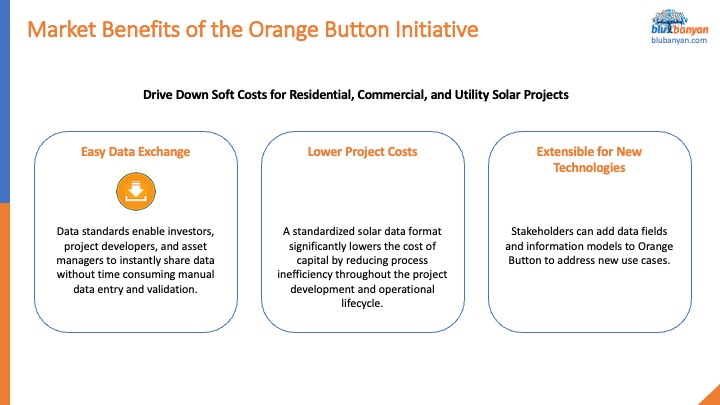
So why do we do this? First, we need to drive down those soft costs. We need to drive down the cost of doing business so that we’re able to put our money and our resources towards actually building the infrastructure that we need for residential, commercial, and utility solar projects. So, the easy data exchange gives us this ability to instantly share data without the time-consuming manual data entry and validation.
That lowers project costs all by itself, but it also reduces the timeline, which further reduces the cost. Then this foundation is extensible for new technologies so that we are future-proofed and we are able to move forward and continue to absorb innovation quickly and effectively into our businesses.
Let’s start with the AHJ Registry.
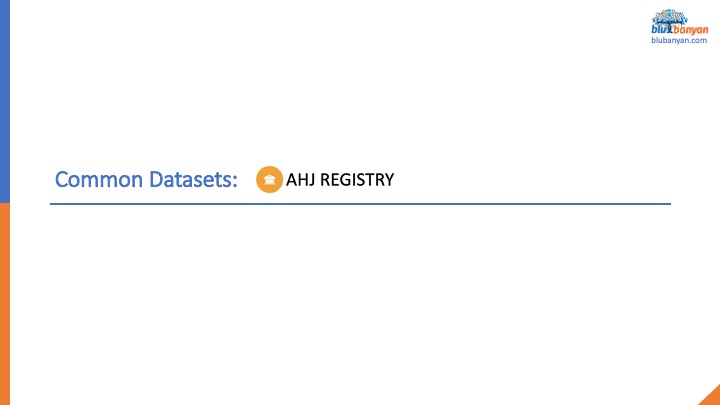
The AHJ (Authority Having Jurisdiction) Registry was released in 2021, and has been available for over a year. It is utilized by many large companies to the extent that we’ve had multiple Google outages and shut downs and had to get those all back up really quick. We had to get our infrastructure scaled because it is used by so many companies at this point in time.

The problem that we were solving is that the AHJs in the United States are very fragmented. As you can see from this picture of Houston, which is in the red versus the purple of Harris County, it is very difficult, even for somebody who did have great tribal knowledge and a lot of experience in selecting their AHJ, it is very difficult for them to know whether they’re in the city of Houston or Harris County, simply because of the complexity of the gerrymandering that has occurred over the years in Houston.
It is really not an easy thing to know which AHJ and which permitting authority you’re supposed you’re supposed to use. So that was literally the single question we were looking to answer. And what we did to pull this together is we found that the Census Bureau already produces polygon data of all of the AHJs.
So, we had complete polygons and there’s technology that draws this so that you can see it. And then we’ve got all these spaces in between that are anti polygons that are not included, and we are able to pull all this together into a conceptual polygon and use a latitude-longitude point from Google, which is just your geolocation coordinates, and compare this with the polygon and find that point inside.
This was a challenge to put this together, but it was coming from existing technologies and existing tools. The Census Bureau has been putting out this polygon data for decades, and Google has had latitude-longitude returns on maps for a decade. So, these tools had been in place, but they didn’t get put together in a way that was commonly accessible until we had the AHJ Registry.
So, a simple question. I have an address, which AHJ does it belong to, was what we were looking to answer.
Let me show you how the AHJ Registry works….
Let’s take a look at this result that you’ll get. And if you look at this in detail, you’ll see that the city of Houston has a very different building code, electric code and fire code that is substantially and materially different than Harris County.
So, if you’re doing solar and it needs to be roof constrained, you are going to need to conform to different specifications based on where you are in which AHJ you’re going to get to. It makes a material difference in your design if it’s 2012 versus 2018.
And over time we are expecting that the AHJs will come to a common set of building codes and standards. But this is going to take time and, in the meantime, we need to get the information right and do it right the first time. So, this is how we’re moving forward. It makes a material difference and you have to know. It saves time, reduces errors and lowers costs.
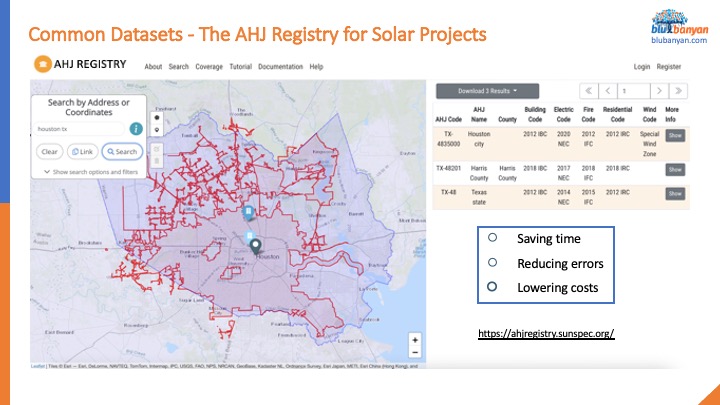
How did we validate that we actually had the right AHJ information?
We were working with NREL (The National Renewable Energy Laboratory) and they are the national labs interested in how accurate this data is. So, we actually back tested with 17,500 residential solar projects that had manually been assigned the AHJs and had permits approved for them.
So, we had the human assigned versus the AHJ registry assigned AHJs to see how we did it.
And we did it across these eight states, which are the bulk of the states in the sunbelt, where we’re interested in the solar impact.
So, we had about 670 AHJs, and what we found is that we had 98.5% identical matches. So, it absolutely works. It’s statistically significant. All of it is fabulous.
And how come it wasn’t a hundred percent? What didn’t work?

We went back and we looked at these 257 manual misses, and what we found is that we had some where the human assigned data that was in the database wasn’t actually the same as what was on the permit. So, the permit was actually issued from the correct AHJ, but what the human had assigned the AHJ that had gotten issued from was wrong.
So, we had just plain old data entry errors. Then we had somewhere where the zip code didn’t match any particular city, and so the zip codes had changed over the time period that we had the historical data. But the most interesting and fun one was when the AHJ registry had assigned the city and county to the correct AHJ, but both the humans and the city or county had assigned the wrong AHJ.
We literally had permits issued to homeowners from the wrong AHJ, that both the human doing the permitting on the solar installer side, and the AHJ thought was right at the time, but didn’t actually match when you looked at the map. So that was funny that both sides, even the counties doing the assignment did not know that they weren’t really allowed to assign our initial permit for those residents.
So, those were the 257 mis-matches. We ended up really feeling much stronger that we needed to have this done automatically rather than manually, when we were done evaluating the misses.
Titan Solar Power was, was a first mover using this initially, and they said that “the ability to automatically assign AHJs eliminates human error, and it streamlines our pre-installation process. This allows the teams to potentially install solar systems quicker and ultimately achieve our end goal of a completed project and a happy customer.”
So, getting the project done faster was a massive win for Titan Solar with no human intervention, no ongoing training as they scale on how to do this. It is just a relief to have it done right, for sure, the first time.
Next, and we just added this in – The Product Registry.

I’m so excited. The industry needs a single source of truth for what is the product.
So why hasn’t this been done before? Why wasn’t this done before the AHJ registry, which involved all this funky polygon math? And there’s some really interesting reasons why it hasn’t happened until just now.
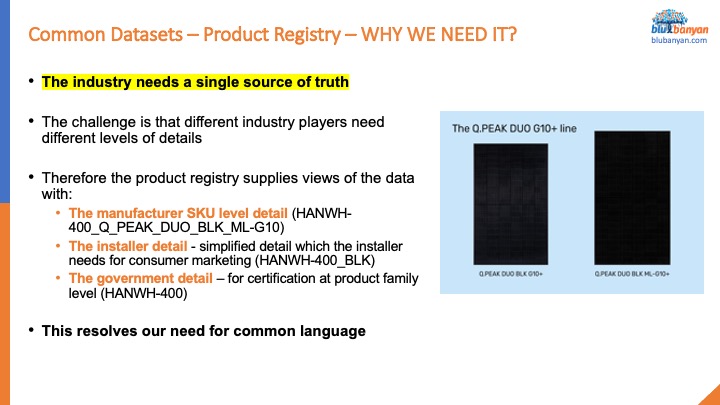
And the challenge is that the different industry players need different levels of details. What different constituencies in the solar industry are willing to substitute for products versus insisting that they get exactly one particular product, has made this a very complex question because if you get too much detail, it’s too hard to maintain and manage and it doesn’t work for smaller or even, you know, reasonably size solar companies. Even large solar companies that gets too much detail.
And so, we had to figure out how to solve this.
So, what we ended up doing is we’re providing different views of the product registry. What’s in the product registry as a whole, is the full manufacturer SKU. It’s the full detail for every single product.
So, if you’ve got a Q-Cell 400, built by Hanwha, you can have five of them that are black-on-black, and five of them that might be silver. And you can see the full detail of everything that’s in there.
But what we’re going to use is, we have a group-by-API mechanism, and what we’re going to use in that grouping API for the installers, is a simplified level of detail.
They would see something like Hanwha-400-Black, and then be able to substitute all the fives, and they’ll just take the first one as what it is that they’re looking for when they place their orders to a distributor of the manufacturer. And then they’ll just explicitly say, any of these five qualify. And I’m, I’m not really concerned about what it is, as long as you can meet pricing constraints.
And that way we’ve got the right level, like a sweet spot of the level of detail the installer needs to manage when they’re receiving and attributing products to a specific job. They need to do it at this higher, simplified level of detail so that the warehouse and the inventory can all stay aligned, and we’re still giving clear instruction to the distributor/manufacturer about what is a valid and acceptable substitution, so that we can make sure that we can get supplied at the right time with what they have on hand.
So, changing what is the full detail on the product registry to a simplified detail for the solar installer, because the installers do not want that full detail, was a key element of changing how this works.
Then the government, like the CEC (the California Energy Commission), needs even a lower level of detail. They are working at things like the Hanwha 400. They just want to see that this product line in general has the required certifications. And so, it’s getting referenced and CEC listed based on even a simpler view of what is available for that product.
And so, by accommodating all of these in a way that we can work with them automatically, and get the full detail where you need it was the solution that we needed to get the product registry actually adopted and generally referenced by a broader audience.
So, this has resolved our need for common language. It is relatively simple and took a little while to think about it, and a lot of consensus building to get everyone to understand how they play together.
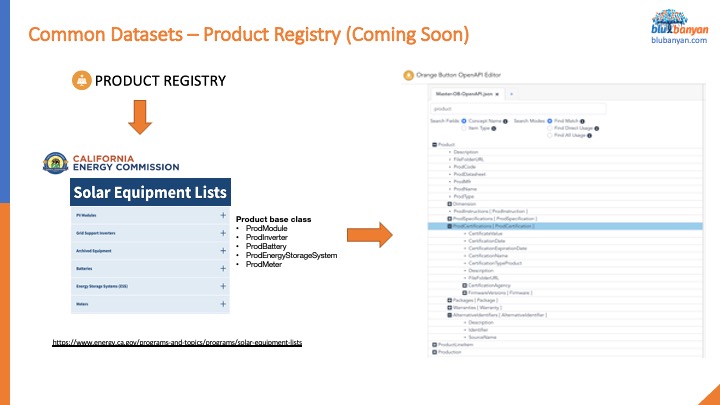
The data that we’ve got in here includes the CEC list, and we’re starting with these five – products, module, inverter, battery, energy storage system, and meter.
And this is where you can see the certification that will be entered by the certifying agency. The product information is going to be entered by the manufacturer. The certifications are going to be done by the certifying agencies – NRTL, SunSpec, UL. And the CEC listing date is going to be coming from the CEC.
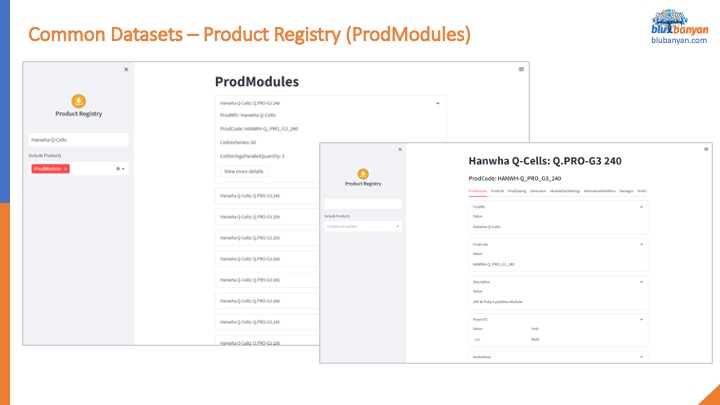
Then we’ll have the common products and the details and you can view more and more details, and see exactly what is in our current module definition. Everything that’s in the CEC is in there – the CEC list and more.
So, we should start to have a common language for better design capabilities across the industry and fewer siloed areas, and also common utilization of data maintenance talent.
And then here you can see the additional detail that becomes available, including units.
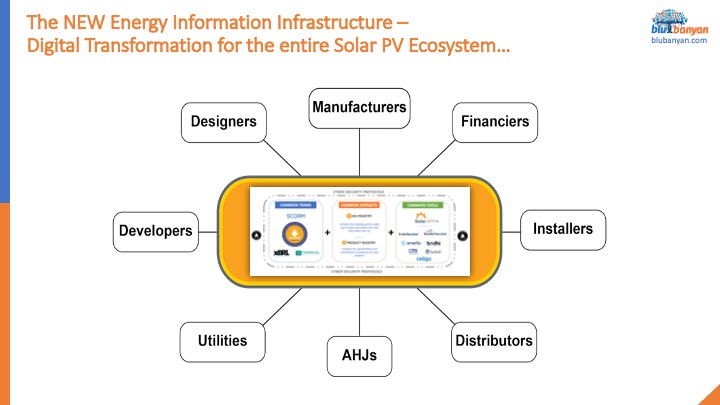
So, in summary, this is the new energy information infrastructure and it is the common data sets piece of this affects the entire industry. Every single one of the players is affected by having these common data sets available. So, everyone industry-wide is benefiting from making this available, and hopefully everyone industry-wide is going to contribute to creating this better world for all of us, going for forward, so that we can deploy more solar faster.
Thank you.


